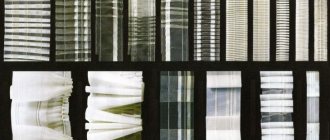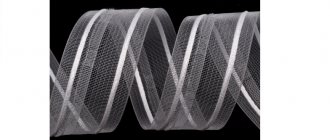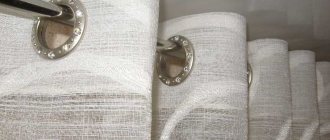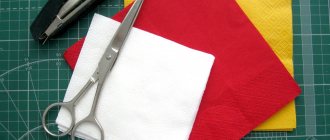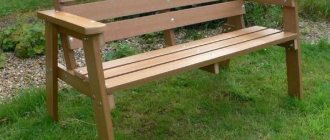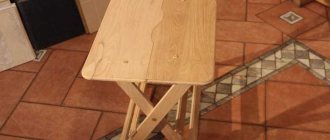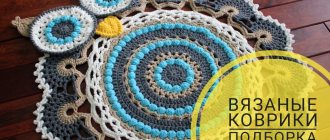The tape is characterized as decorative accessories. This is a special curtain type of decoration, a type for curtains that forms folds of various sizes and shapes.
A soft frame that allows you to play with a lot of assembly options. Before hanging curtains on the windows, it is worth providing them with an auxiliary ribbon, which will help make the curtains beautiful. The interior of the room is immediately transformed.
Curtain tape is sewn from natural and synthetic fabrics with different densities. It allows the canvas to keep its shape. If you sew the braid to the curtains, they are more convenient and easier to secure. There is no longer a need for metal clips or sewing on loops.
Curtain tapes have several dozen types, varying in type of material. They are also distributed according to cost. The difference between the varieties is also visible in the following characteristics:
- According to fixation methods. You can sew eyelet tape to the curtain. This is one of the mounting methods. There are types that are arranged in the form of strings or pipes, and are fixed in the form of sticky stickers.
- According to the configuration of the tail. Any option is possible. It all depends on the desire of the person.
- By size. A standard ribbon has a width from 1.5 to 10 cm. There are wider ribbons, from 2.5 and 6 cm.
- According to the material. For thick, heavy curtains, it would be logical to work with polyester or cotton braid.
Photo gallery
Why do you need curtain tape?
The choice of curtain tape is expressed in several important points. They can be defined as the functions that it performs:
- With its help, it is possible to create a variety of folds, folds, and puffs from fabrics of different densities. Decorating curtains with braid creates assemblies of varying complexity;
- the tape helps to process the top of the curtains;
- it becomes possible to hang curtains from a cornice or rod, eliminating clothespins and rings;
- the tape gently drapes the curtains, creating a variety of patterns on them;
- curtains are shortened without trimming. You can place the fasteners on the bottom row of fittings.
Selection criteria and length calculation
Parameters to pay attention to:
braid material: for transparent or thick fabrics; number of rows with loops (1 or more): in this case, you need to take into account the length of the curtain; if you need to hem the product, attach it to the bottom row of loops, otherwise, to increase the length (fix it along the top row); the width of the tape is from 2 to 10 cm, the wider variety is used for heavy curtains, the narrow one is used for light, transparent curtains; the width of the edge on which the tape will be fixed is also taken into account; when choosing, you need to take into account the assembly coefficient - one of the characteristics of the braid; in order to calculate it, you need to know the width of the curtains in their initial form and after assembling the material, the range of values is quite wide, in most cases they take the indicator 1.5 as a basis, for complex drapery - 3.
Additionally, you can study the markings of the braid. This will allow you to determine the intended purpose of the product. For example, if among the characteristics there is the letter “Z”, you need to use a tape for, for light ones choose the option marked “F”, for transparent ones - “/Z”. The universal option is “U”.
How to sew curtain tape onto curtains
The question of how to sew ribbon to a curtain seems simple.
But there is a catch hidden in it. In fact, careful preparation for the process is required. Especially when it comes to the complex double-sided type of curtains. To sew curtain tape to a curtain, careful selection of threads is required. Their color should match the tone of the fabric. The seams that will be located along the face of the canvas will become invisible.
A mistake could be purchasing accessories before purchasing the canvas. In this case, you will have to look for curtains, matching them to the braid. It's better to do the opposite. It is important to calculate the fabric and select the correct ribbon length in order to complete all the folds. It's better if it comes with a reserve.
We calculate the sizes
In the proposed example, the assembly coefficient is minimal. The curtain tape is narrow and dense. The braid must be equipped with hooks.
The width parameter of the curtains, in accordance with the rule, is made equal to the same parameter of the cornice, multiplied by the assembly factor “K”. Add 15 to 25 cm to fold in the sides and ensure proper shrinkage.
For a cornice 150 cm long, braid dimensions: K=2. 150 * 2 + 25 = 3.25 m. The length of the curtain increases by 12 cm so that you can make a hem:
- 2 cm is taken to bend the upper curtain part;
- 10 cm remains for the bottom hem.
The length of the tape is determined by the sum of the width of the folded curtain with the addition of safety 50 cm for shrinkage.
Checking for bevels and shrinkage
The material is checked for evenness of the cut when it is purchased.
The curtains on which the pattern is located are easier to align. Plain fabric, before sewing on the braid, should be aligned in such a way as to make the edge strictly perpendicular to the passage of the grain line. Perform bevel cutting. The cut is checked by securing it in a vertical position. The presence of distortions and the upper tension of the side are checked.
Avoiding the consequences of shrinkage
To prevent shrinkage of the material, a piece of fabric after alignment is placed in warm water and washed without adding powder. Then dry and iron. This operation will prevent the material from shrinking after the tape is secured.
Before sewing, the tape is wetted and dried so that shrinkage does not occur. This is important not only for thick curtains. This is of particular importance if the ribbon is placed on organza and veil.
Setting up the machine correctly
To properly sew the tape to the curtain, you need to set up your sewing machine.
- To make the seam beautiful, adjust the thread tension. For preliminary testing, it is better to use a small piece of material for testing. It is necessary that the stitching goes smoothly and the threads do not stick out.
- It is necessary to adjust the pressure of the sewing machine foot on the material. If it is strong, the material will wrinkle and tighten. An iron cannot smooth out such a seam. You need to adjust the presser foot pressure, set it to the types of fabric.
Preparing the curtain
The curtain tape is hemmed to the prepared curtain, having previously trimmed the factory edges on the material. When hemming, they help tighten the fabric. Having retreated 1.5 cm from the edge, the vertical thread is pulled out. The resulting line allows you to make a cut and fold the side edge. Stitching and steaming are carried out.
The bottom is folded, stitched, steamed. The top of the curtain is being processed. A fold of 2 cm is made. Delicate ironing and basting is required. After all operations, the textile strip is sewn on and the drapery is formed.
How to sew braid to curtains: step-by-step instructions
The fabric is ironed and the cut edges are processed. Usually a double hem is made at the bottom. This method of hemming, eliminating trimming, shortens the product. Using double hemming, up to 30 cm of fabric can be removed.
- Before stitching the braid, the top edge is processed. Fold it to the selected amount and carefully iron the material, taking into account its density and texture.
- The basting is done manually. The tape is first folded. A couple of centimeters are enough for this. The hem is fixed with tailor's needles.
- The curtain is placed face up. The front side of the braid is placed on it.
- The firmware is being flashed on the machine. Determining the exact number of seams is based on the parameters of the tapes:
- a narrow ribbon is made with 2 seam lines on both parts;
- with a width of up to 12 cm, 3 lines should be made, where the third middle seam is auxiliary;
- on a wide type of braid, perform 4 lines.
- The sewing of the folded allowance occurs from the wrong side. The first seam runs along the edge of the tape.
- The end of the seam allowance is turned inwards.
- The curtain unfolds with the wrong side up. The tape is folded over the curtain so that 0.5 cm is obtained from its border to the fold line. The allowance is used to hide the hooks behind the curtain.
- The second seam also runs along the edge of the ribbon. The front side is made smooth and neat.
- As soon as the ribbon is stitched, the ropes are tightened. A version of the intended pattern is created.
Fabric preparation process
Before you sew the braid to the curtain, you need to prepare it. For this:
- The curtain must be ironed. There should be no folds on it. Iron fabric according to the care instructions for the fabric it is made from.
- If the edges are not cut, hem the fabric by folding it in half.
- Check the loops on the ribbon using an awl, screwdriver, or other thin object. Do this to avoid sewing the tape on the wrong side.
To remove the curtains, simply untie the laces and straighten the tape.
How to sew ribbon for hanging curtains on a ceiling cornice
Attaching curtains to ceiling cornices is a labor-intensive process. This cornice has special hooks for hanging. Curtains require mounting tape, including for beautiful draperies.
The work is performed according to the proposed algorithm:
- The strength of fastening the ribbon to the material should be calculated.
- The strings are pulled out, gathered and tied at one end of the ribbon. This reduces the width of the curtains and creates clear folds.
- Hooks are used to attach to the curtain. They are connected by sewn loops, which are located in the mounting tape. The distance between the loops should be 10 cm.
- The fasteners are attached to the cornice.
The work is completed by checking the strength of the fasteners fixed to the cornice.
Main varieties
Curtain braid comes in several types. The transparent one is made of leka and is used to decorate tulle and organza. Opaque options made of polyester or cotton are intended for hemming thick fabrics. According to the method of fastening, the following types are distinguished:
- using hooks;
- combined - with hooks and Velcro;
- adhesive tape (for lambrequins and Roman blinds);
- on string cornices;
- grommet fastening.
The width of the tapes varies from 2 to 10 cm. Most often, braid with a width of 2.5 or 6 cm is used. Narrow options are used for closed and ceiling cornices or if the top of the curtain is hidden by a lambrequin. Wide tapes are suitable for open cornices. In this case, the loops can be covered with the top edge of the braid if decorative gathering is needed.
How to sew tape to curtains to cover a cornice
Sometimes it is necessary for the cornice to be masked with curtain tape. This eliminates various conspicuous imperfections. A braid is placed on the cut from the inside. It is made invisible from the face, so it is sewn on, lowering the edge of the material 0.3-0.5 cm below the line. Thus, the cornice overlaps.
Formation of folds
In addition to knowing how to sew curtain tape to curtains, you should familiarize yourself with the rules for making beautiful folds.
To make it work, the ribbon is supplied with three to four cords. They tie together at both ends. First, the elastic band is stretched. The assembled cords with a knot are grabbed with one hand. With the other hand, you should gather the braid from the edges and reaching the center. The fabric moves evenly along the rope.
You get folds. Loose ropes, increased in length, are wound on cardboard.
Simple folds are created using ribbons that have two rows of loops. Types that have 3-4 rows of loops create a decorative decoration for the top of the curtain.
What folds can be created using tape?
Each braid has its own gathering factor, which shows how many times the width of the fabric should be greater than the final width of the curtain. For example, if the gathering factor is 1.5, then to sew a curtain 3 m wide on such a tape you will need:
3 m * 1.5 = 4.5 m of fabric. The coefficient can be from 1.5 to 3. You need to know it in order to calculate the amount of fabric and correctly sew the tape to the curtain.
The braid is sewn onto a straight piece of fabric, i.e. the length of the braid is equal to the width of the unassembled curtain.
When threads are pulled together on different types of products, different types of folds are obtained.
Simple assembly (accordion).
Use for tulle and other thin fabrics. The width of the braid is 6 cm, the gathering factor is 1.5. Provides thin parallel folds, hang it on hooks, a thin rod or string. Classic (pencil assembly).
Narrow vertical folds. Width 7.5 cm, build factor 2.5. Three rows of pockets for hooks. Sleeve folds (wave).
Rows of round folds. Width 9–10 cm. Build factor 2.
Sew it to long curtains and drapes. They are hung on special detachable hooks. The braid has three cords and three lines of pockets.
When choosing a tape, pull a small section to test. The folds should be uniform and firmly hold the shape of the braid.
French pleats (triple tuck).
Width 8.5 cm, coefficient 2. When assembled, the tape forms groups of folds of three tucks. Can be used for any fabric; it is better to choose a long one.
Do not overtighten the cord, otherwise all the charm of the design will be lost. The braid has two rows of pockets for detachable hooks. Double pleated. The 10 cm wide ribbon has 4 cords and 2 pockets.
Gather factor 2. Forms three rows of thin folds in a checkerboard pattern. Counter pleats. Placed manually or using curtain tape.
The width of the braid is 7.5 cm, pockets in two rows for detachable hooks, coefficient 2. Diamond fold (waffle, butterfly, checkerboard). Ribbon width 7.5 cm, two rows of pockets for regular hooks, gathering factor 2.5. Glasses (Flemish pleats). Three to five deep tucks forming a “goblet stem” and then merging into one large round fold.
Fold for long curtains. Coefficient 2–2.5. Detachable metal hooks. Bow.
Tape width 5 cm, two pockets for hooks, 2 or 4 cords, coefficient 2.5–3. You can sew such a braid on a short curtain or on frills. Not recommended for sliding curtains.
Common mistakes made by newbies
Mistakes made by beginners are due to their lack of sewing experience. Many beginners do not strive to learn how to properly sew curtain tape, as they consider it a simple matter. When it comes time to sew and design the ribbon yourself, important points are overlooked.
- The curtain material, after installing the braid, is washed and shrinks. To eliminate new cutting and alteration, the tape is left with an additional margin;
- In the middle of the braid there is a tightening seam. When working, a careless beginner, for example, is able to cut it. Curtains sag because the tape is not tensioned properly.
Making a choice
Curtains need to be changed periodically. This process can sometimes be expensive, since if you have more than one window, or large windows, then you will have to spend a lot of money just to sew the curtain braid in the studio. Many people are trying to find various videos on the Internet that will explain how to properly sew curtains for windows, as well as how to sew braid to them. However, such a lesson may not always bring maximum benefit, since it cannot cover all aspects. Brief information can sometimes be much more effective and intelligible than video material.
Sewing curtains is a rather labor-intensive process, which also requires some special knowledge and experience:
If you are not sure that you can handle this matter yourself, then you probably don’t need to start, but simply hand over the material to a specialized studio;
You can also start by trying to sew a ribbon with a large width onto the fabric for the kitchen window, and if everything goes well, then you can start sewing the ribbon on more expensive curtains.
Tips from an experienced seamstress
Craftswomen are happy to share their sewing knowledge. On the Internet, their advice is presented accompanied by photographs of their work and videos. The tips are simple. For example, you can pay attention to the following:
- When the curtain tape is trimmed, a few more centimeters are removed. This is how the bend is performed. For action you need the inside of the canvas.
- If the ribbon is sewn to tulle or organza, the condition requires that it lie on the fabric, one and a half centimeters below the edge of the top of the fabric. It turns out that most of the width of the ribbon protrudes from behind the tulle, remaining visible. On the sides of the curtains, the remaining ends of the ribbon are not cut, but are bent, clasping the tulle, forming smooth edges of the top.
Curtains, secured with curtain tape, drape vertically and horizontally. The braid is sewn to a lambrequin, tulle, or thick night curtain. Knowing how to hang curtains on curtain tape on hooks, it is easy to make a cascade or a line of even folds.
Sewing order
After selecting the material, you can start sewing. To sew curtains, you need the following equipment:
- sewing machine;
- threads;
- needles;
- tailor's centimeter;
- scissors.
You may also need safety pins during the process. You need to do the following step by step:
- The length of the tape is measured with a small allowance of 4-5 cm.
- The upper part of the curtain is folded up about 2 or 3 cm and ironed. The wrong side of the braid is applied to the wrong side of the curtain with an indentation of 0.5 or 1 cm.
- Basting is done using large stitches. It is permissible to use safety pins instead of hand basting.
- The braid should be sewn to the curtain with two lines. First you need to stitch the top edge, then the bottom. The number of lines should be equal to the number of cords.
- After completing the stitching, the ends need to be tied so that they do not come out of the fabric, then pull the cords evenly on one side until uniform folds are obtained, which must be distributed along the entire length.
We receive ready-made curtains.
Curtain braid allows you to get excellent drapery yourself with even folds of the same depth. The volume and splendor of the gathers can be adjusted. The advantage of the tape is that curtains or tulle can be easily removed: if necessary, the curtain can be removed, untied, folded for storage or washed.
The more complex the decor and folds, the wider the braid is needed. The curtain fabric may become short after washing. Before hemming, the fabric must be soaked in warm water, dried and ironed.
Important: after the folds are made, the cords should not be cut. They will be needed if the curtain needs to be straightened when dismantled for storage or washing.
Photo of curtains on curtain tape, hanging on hooks
Any style is acceptable for window decoration. In the selection of photos you can find draperies of light, heavy, soft and hard fabrics. For high-tech or minimalist interiors, choose laconic curtain decor. Provence and shabby chic are tenderness and airiness. A living room in a classic, baroque style will be decorated with a chic lambrequin.
Peculiarities
To attach curtains to curtains or ceiling cornices, fastenings are required. Fittings are made from various materials:
- metal-plastic;
- non-ferrous metal;
- aluminum;
- become;
- light and durable polymer.
Hooks or rings usually come with curtain rods. Toothed crocodile clips are used for heavy materials, clips are used for organza and tulle.
How to hang curtains
Housewives who know various methods of attaching curtains independently decide how best to hang curtains on a strip. Drapery options:
- “pencil”, which is suitable for veils, the material hangs almost without gathering;
- “columns” are rows of folds of the same size, the density is determined by the tension force of the cord;
- uneven waves-buffs are made on curtains with lurex or a metallic sheen; the curtain tape will need to be wide, with 4 threads;
- a medium-density curtain is gathered in a “fan” pattern;
- the beautiful butterfly relief with a diamond-shaped screed looks elegant;
- “glass” or “glass” with a lower double tuck of ribbon-braid;
- Counter folds are practiced on soft woolen fabrics.
The braid is selected taking into account the assembly coefficient, the number of cords on which the fit density depends.
Types of draperies
An important parameter of the drapery tape, which influences the calculation of its length when purchasing, is what folds it creates after sewing. The choice of drapery depends on the type of fabric, as well as the style of window design:
- “Pillars” are evenly spaced folds. Their number and frequency depend on how tightly you tighten the cord on the tape. This curtain is suitable for modern interiors.
- “Pencil” (installation factor 2-3.5) is the simplest, classic installation option. Suitable for any style, does not attract attention with its simplicity.
- “Buffi” (coefficient - 1.5-2.5) form folds reminiscent of waffles. Suitable for classic interiors or others where jacquard fabrics, velvet, and satin are used in decoration.
- French fan. The fabric forms folds in the form of small fans. The drape factor is 2.5.
- Bow folds (2.5-3). The folds, gathered together, form small bows that look very cute in a child's room.
- “Bowls” (2-3) are the most extensive drapery option. In appearance, the folds resemble the shape of glasses.
The choice of curtains depends on the type of fabric and window design style.
In fact, these numbers show how many times more fabric is needed to cover the entire window when folded.
How to sew ribbon to curtains
The sequence of operations is presented in a small master class:
- sew the curtain, trim the edges on all sides;
- cut the braid, the length of the piece exceeds the width of the curtain by 5 cm;
- bend the ends inward by 2.5 cm on both sides, secure with a pin;
- pin or baste the fastening strip at the desired height from the wrong side of the material;
- Sew the tape along the top and bottom edges.
The cord should be loose, folds are made later. You need to sew the ribbon-braid in a medium step.
Calculating fabric consumption
If you tighten the braid cords, folds will form, which can reduce the width of the curtains several times. This point is extremely important from the point of view of correct calculation of the consumption of both the material needed for sewing curtains and braid.
To describe this point more clearly, let’s take as an example a standard type window, which is 130 cm wide:
- It is necessary to calculate the amount of tulle, as well as curtain fabric, so that the curtains have a well-collected fold. The width of the window is not important, you only need to note the width of the window cornice;
- The next step is to identify the fold coefficient. If you want the curtain to be doubled, you will need about 3 meters of material.
Step-by-step instruction
When the curtain is ready, proceed to the final design procedure.
First, check the reliability of the cord, release and tie the ends at each edge so that they do not fly out when tightening. How to properly hang a curtain on a curtain tape:
- take a hook or ring, hook it onto a fabric loop, repeat the operation with all fasteners;
- when the curtains are hung, make folds according to the chosen pattern, adjusting the length of the thread;
- fasten the free ends of the thread, wind it into a skein, and hook it onto the cornice.
It is important to maintain a distance between loops of at least 5 cm so that the fabric does not sag.
Set of equipment, tools, materials:
1. Depending on the width of the awning, you can sew it with or without folds. If the width of the awning is much larger than the width of the window opening, it is necessary to provide folds. In our case, the width of the curtains corresponds to the width of the window opening, so curtain tape is needed to hold the curtains on the hooks. Our option is blinds without folds.
When adjusting the height of the curtains, I had to subtract some length. In order not to touch the openwork at the bottom of the curtain, I did it at the top, where we will sew the braid.
3) Experienced seamstresses make curtain edging without the help of an iron. To make your task easier, you can use an iron. Fold a 5mm seam allowance along the top edge of the curtain and press to prevent frayed edges. 4.
4. Fold the other edge of the seam allowance over the width of the tape to hide the cut edges. 5.
Then adjust the length of the braid by folding the edges. Tie the ends of the cord, which are also hidden behind the hem.
Master class on sewing braid for curtains:
Features of hanging tulle
For fastening, hooks and rings are used, sometimes the canvas is attached to a pipe, and a special pocket is made along the entire width.
For drapery you will need transparent braid with a gather factor of more than 2.5. It is better to choose adhesive-based options. Standardly, the strip is attached to the folded edge, first sewn on top. For decorative purposes, up to 20 cm is removed from the top edge. The tulle will have visual lightness and airiness.
The fabric is usually gathered with an accordion or deep folds are made with a certain step.
Selection of material
Any curtain is hung on the window with a small gather. How to calculate the length correctly? For example, you need to hem a curtain on a window 3 meters long. The tape has a build factor k. For example, k=1.5. To get a curtain of the required length, you need to calculate the width of the canvas and multiply the length by the coefficient (3x1.5 = 4.5). Thus, you need to buy a canvas 4.5 meters wide.
Coefficients range from 1.5 to 3. The length of the braid should be equal to the width of the fabric. It should be taken into account that different fabrics have different degrees of contraction depending on the density.
